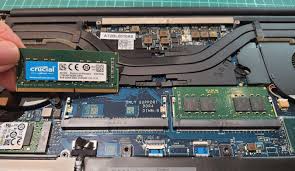Adding RAM to Your Laptop: A Quick Guide
Is your laptop running slow? One of the easiest and most cost-effective ways to boost its performance is by adding more RAM. Here’s a quick guide on how to do it:
Step 1: Determine Compatibility
Before purchasing new RAM, make sure it is compatible with your laptop. Check your laptop’s specifications or use online tools to find out the type and maximum capacity of RAM it can support.
Step 2: Purchase the Right RAM
Once you know what type of RAM your laptop supports, purchase the right amount and speed of RAM. Make sure to buy from a reputable manufacturer to ensure quality.
Step 3: Prepare Your Workspace
Turn off your laptop, unplug it, and remove the battery if possible. Find a clean, well-lit workspace with enough room to work comfortably.
Step 4: Open Your Laptop
Locate the compartment for the RAM on your laptop. This is usually found on the bottom of the laptop and can be opened with a screwdriver. Be gentle when opening to avoid damaging any components.
Step 5: Install the New RAM
Gently insert the new RAM module into the slot at a 45-degree angle until it clicks into place. Make sure it is firmly seated in the slot before closing the compartment.
Step 6: Close Up Your Laptop
Carefully close up the compartment and secure it with screws. Put back the battery (if removed) and plug in your laptop.
Step 7: Test Your Laptop
Turn on your laptop and check if it recognizes the new RAM. You can do this by checking in your system settings or using diagnostic tools.
Congratulations! You have successfully added more RAM to your laptop, boosting its performance and speed. Enjoy your faster computing experience!
5 Essential Tips for Successfully Adding RAM to Your Laptop
- Check your laptop’s specifications to ensure compatibility with the new RAM
- Purchase RAM modules that match your laptop’s requirements in terms of type, speed, and capacity
- Power off and unplug your laptop before installing the new RAM to prevent damage
- Handle the RAM modules carefully by holding them on the sides to avoid static discharge
- After installing the new RAM, make sure to properly seat it in the memory slot and secure it with the retention clips
Check your laptop’s specifications to ensure compatibility with the new RAM
Before adding RAM to your laptop, it is crucial to check your laptop’s specifications to ensure compatibility with the new RAM. By verifying the type and maximum capacity of RAM that your laptop supports, you can avoid potential issues such as incompatibility or performance issues. Taking this simple step will help you make an informed decision when purchasing and installing new RAM, ultimately optimizing your laptop’s performance effectively.
Purchase RAM modules that match your laptop’s requirements in terms of type, speed, and capacity
When adding RAM to your laptop, it is crucial to purchase RAM modules that align with your laptop’s specific requirements in terms of type, speed, and capacity. Ensuring compatibility between the new RAM and your laptop guarantees optimal performance and prevents any potential issues. By selecting the right type, speed, and capacity of RAM modules, you can effectively enhance your laptop’s overall speed and efficiency, providing a seamless computing experience.
Power off and unplug your laptop before installing the new RAM to prevent damage
It is crucial to power off and unplug your laptop before installing new RAM to prevent any potential damage. By shutting down the laptop and disconnecting it from any power source, you ensure that no electrical current is running through the device while you handle sensitive components. This simple precaution can help protect both your laptop and the new RAM module from any harm during the installation process.
Handle the RAM modules carefully by holding them on the sides to avoid static discharge
When adding RAM to your laptop, it is crucial to handle the RAM modules with care. To prevent static discharge, always hold the RAM modules on the sides rather than touching the gold connectors. Static electricity can damage the sensitive components of the RAM, so by holding it properly, you can ensure a smooth and successful installation process without risking any potential damage.
After installing the new RAM, make sure to properly seat it in the memory slot and secure it with the retention clips
After installing the new RAM in your laptop, it is crucial to ensure that it is properly seated in the memory slot and securely fastened with the retention clips. This step is essential to guarantee that the RAM is making a solid connection with the motherboard, allowing for optimal performance and stability. By taking the time to securely install the RAM and ensure it is correctly seated, you can maximize the benefits of upgrading your laptop’s memory capacity and enjoy a smoother computing experience.
Tags: adding ram, adding ram to laptop, clicks into place, close up, compatibility, diagnostic tools, install, laptop, manufacturer, module, open, performance, purchase, recognizes, secure, slot, specifications, system settings, test, workspace
